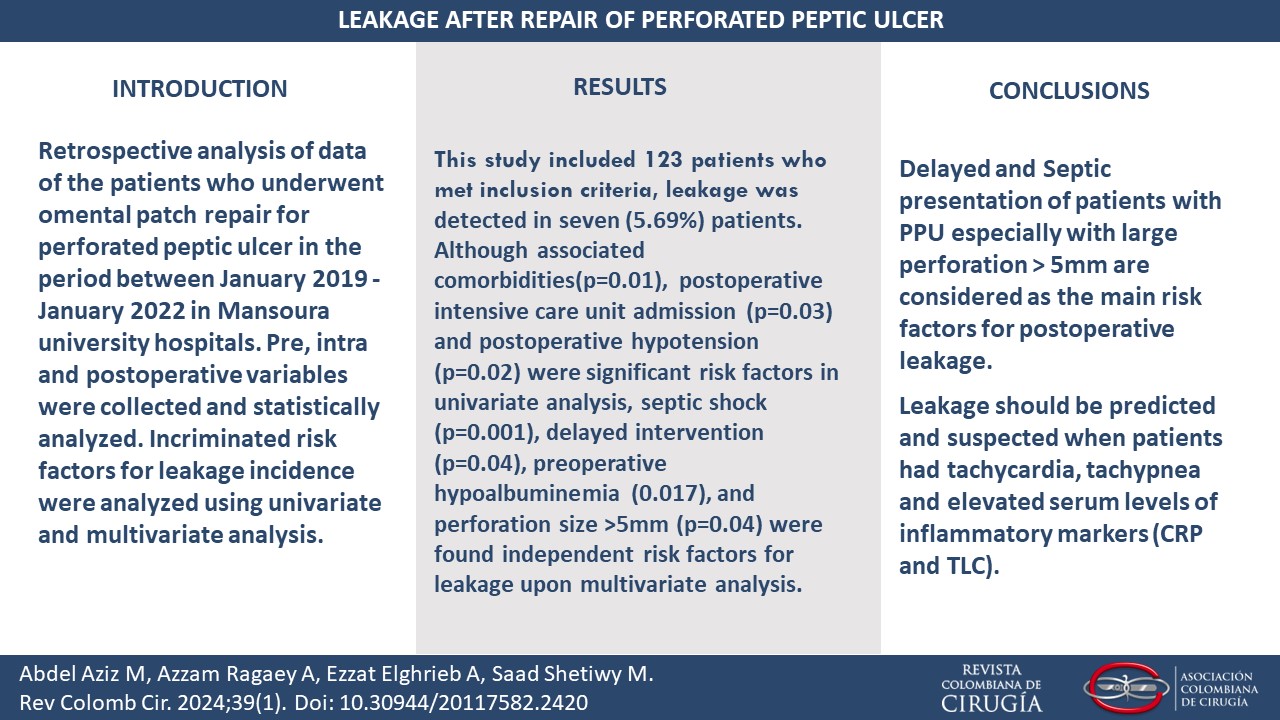Assessment of risk factors for leakage after repair of perforated peptic ulcer with omental patch. Retrospective study
DOI:
https://doi.org/10.30944/20117582.2420Palabras clave:
peptic ulcer perforation, omentum, patch, leak, risk factors, postoperative complicationsResumen
Introduction. Perforated peptic ulcer remains one of the critical abdominal conditions that requires early surgical intervention. Leakage after omental patch repair represents one of the devastating complications that increase morbidity and mortality. Our study aimed to assess risk factors and early predictors for incidence of leakage.
Methods. Retrospective analysis of data of the patients who underwent omental patch repair for perforated peptic ulcer in the period between January 2019 and January 2022 in Mansoura University Hospital, Egypt. Pre, intra and postoperative variables were collected and statistically analyzed. Incriminated risk factors for leakage incidence were analyzed using univariate and multivariate analysis.
Results. This study included 123 patients who met inclusion criteria. Leakage was detected in seven (5.7%) patients. Although associated comorbidities (p=0.01), postoperative intensive care unit admission (p=0.03), and postoperative hypotension (p=0.02) were significant risk factors in univariate analysis, septic shock (p=0.001), delayed intervention (p=0.04), preoperative hypoalbuminemia (p=0.017), and perforation size >5mm (p= 0.04) were found as independent risk factors for leakage upon multivariate analysis.
Conclusion. Delayed presentation in septic shock, preoperative hypoalbuminemia, prolonged perforation, operation interval, and large perforation size > 5mm were detected as independent risk factors for leakage. Postoperative tachypnea and tachycardia with increased levels of C-reactive protein and total leucocytic count are alarming signs for incidence of leakage.
Descargas
Referencias bibliográficas
Thorsen K, Søreide JA, Kvaløy JT, Glomsaker T, Søreide K. Epidemiology of perforated peptic ulcer: Age- and gender-adjusted analysis of incidence and mortality. World J Gastroenterol. 2013;19:347-54. https://doi.org/10.3748/wjg.v19.i3.347
Arroyo-Vázquez JA, Khodakaram K, Bergström M, Park PO. Stent treatment or surgical closure for perforated duodenal ulcers: a prospective randomized study. Surg Endosc. 2021;35:7183-90. https://doi.org/10.1007/s00464-020-08158-3
Bertlef MJOE, Lange JF. Perforated peptic ulcer disease: A review of history and treatment. Dig Surg. 2010;27:161-9. https://doi.org/10.1159/000264653
Thorsen K, Glomsaker TB, von Meer A, Søreide K, Søreide JA. Trends in diagnosis and surgical management of patients with perforated peptic ulcer. J Gastrointest Surg. 2011;15:1329-35. https://doi.org/10.1007/s11605-011-1482-1
Thorsen K, Søreide JA, Søreide K. What is the best predictor of mortality in perforated peptic ulcer disease? A population-based, multivariable regression analysis including three clinical scoring systems. J Gastrointest Surg. 2014;18:1261-8. https://doi.org/10.1007/s11605-014-2485-5
Anbalakan K, Chua D, Pandya GJ, Shelat VG. Five year experience in management of perforated peptic ulcer and validation of common mortality risk prediction models - Are existing models sufficient? A retrospective cohort study. Int J Surg. 2015;14:38-44. https://doi.org/10.1016/j.ijsu.2014.12.022
Maghsoudi H, Ghaffari A. Generalized peritonitis requiring re-operation after leakage of omental patch repair of perforated peptic ulcer. Saudi J Gastroenterol. 2011;17:124-8. https://doi.org/10.4103/1319-3767.77243
Kumar K, Pai D, Srinivasan K, Jagdish S, Ananthakrishnan N. Factors contributing to releak after surgical closure of perforated duodenal ulcer by Graham’s Patch. Trop Gastroenterol. 2002;23:190-2.
Lunevicius R, Morkevicius M. Management strategies, early results, benefits, and risk factors of laparoscopic repair of perforated peptic Ulcer. World J Surg. 2005;29:1299-1310. https://doi.org/10.1007/s00268-005-7705-4
Wang YL, Chan XW, Chan KS, Shelat VG. Omental patch repair of large perforated peptic ulcers ≥25 mm is associated with higher leak rate. J Clin Transl Res. 2021;7:759-66.
Lund S, Chauhan KK, Zietlow J, Stephens D, Zietlow S, Strajina V, et al. Risk factors for gastrointestinal leak after perforated peptic ulcer disease operative repair. Am Surg. 2021;87:1879-85. https://doi.org/10.1177/00031348211056263
Wiedermann CJ. Hypoalbuminemia as surrogate and culprit of infections. Int J Mol Sci. 2021;22:4496. https://doi.org/10.3390/ijms22094496
Arroyo-Vázquez JA, Khodakaram K, Bergström M, Park PO. Stent treatment or surgical closure for perforated duodenal ulcers: a prospective randomized study. Surg Endosc. 2021;35:7183-90. https://doi.org/10.1007/s00464-020-08158-3
Lunevicius R, Morkevicius M. Risk factors influencing the early outcome results after laparoscopic repair of perforated duodenal ulcer and their predictive value. Langenbeck’s Arch Surg. 2005;390:413-20. https://doi.org/10.1007/s00423-005-0569-0
Bertleff MJOE, Lange JF. Perforated peptic ulcer disease: A review of history and treatment. Dig Surg 2010;27:161-9. https://doi.org/10.1159/000264653
Gupta S, Kaushik R, Sharma R, Attri A. The management of large perforations of duodenal ulcers. BMC Surg 2005;5:15. https://doi.org/10.1186/1471-2482-5-15
Gona SK, Alassan MK, Marcellin KG, Henriette KY, Adama C, Toussaint A, et al. Postoperative morbidity and mortality of perforated peptic ulcer: Retrospective cohort study of risk factors among black africans in Côte d’Ivoire. Gastroenterol Res Pract. 2016;2016:2640730. https://doi.org/10.1155/2016/2640730
Liu J, Zhou S, Wang S, Xue X. Analysis of risk factors for duodenal leak after repair of a duodenal perforation. BMC Surg. 2023;23:116. https://doi.org/10.1186/s12893-023-02005-7
Irvin TT. Mortality and perforated peptic ulcer: A case for risk stratification in elderly patients. Br J Surg. 1989;76:215-8. https://doi.org/10.1002/bjs.1800760304
Khalil AM, Elfeky KA, El Hefny AM, Abd El Monaem AH. Outcome of simple closure with omental patch repair in pre-pyloric and duodenal ulcer. Med J Cairo Univ. 2022;90:1021-9. https://doi.org/10.21608/mjcu.2022.257366
Luo J, Wu H, Jiang Y, Yang Y, Yuan J, Tong Q. The role of heart rate, body temperature, and respiratory rate in predicting anastomotic leakage following surgery for rectal cancer. Mediators Inflamm. 2021;2021:8698923. https://doi.org/10.1155/2021/8698923
Elkerkary MA, Elnagar M, Ali MA, Shaban H. Evaluation of the predictive value of serum C-reactive protein and procalcitonin levels in early detection of anastomotic leakage after gastrointestinal surgery. Suez Canal Univ Med J. 2020;23:30-40. https://doi.org/10.21608/scumj.2020.116350

Descargas
Publicado
Cómo citar
Número
Sección
Licencia
Derechos de autor 2023 Revista Colombiana de Cirugía

Esta obra está bajo una licencia internacional Creative Commons Atribución-NoComercial-SinDerivadas 4.0.
Todos los textos incluidos en la Revista Colombiana de Cirugía están protegidos por derechos de autor. Las opiniones expresadas en los artículos firmados son las de los autores y no coinciden necesariamente con las de los directores o los editores de la Revista Colombiana de Cirugía. Las sugerencias diagnósticas o terapéuticas como elección de productos, dosificación y métodos de empleo corresponden a la experiencia y al criterio de los autores.


















.jpg)


